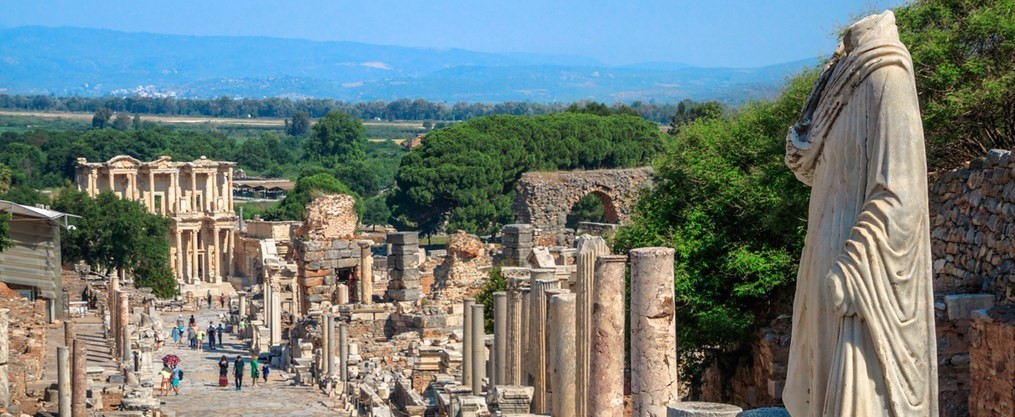Ephesus Tour

Ephesus Tour
The ancient city of Ephesus has gained global attention by its addition to the UNESCO World Heritage list in 2015. As the most famous archaeological site in Turkey, Ephesus attracts all travelers from all over the World.
The exceptional condition of the ruins must not distract us from viewing the historical aspect as well. It was started from the Neolithic period and reached the peak of its prosperity by becoming the most important city in Anatolia under the rule of the Roman Empire. The various remains in the area reflect centuries of history from the Neolithic, Hellenistic, Roman, Byzantine, Selcuk and Ottoman periods.
We will introduce you highlights of this greatest archaeological site with their historical background through our tour;
- Ephesus Ancient City
- Isabey Mosque
- House of Virgin Mary
Ephesus Ancient City

(Imaged Picture) Left: Temple of Artemis, Middile: Celsus Library, Right: Temple of Hadrian
This is the place that comes to your mind when you hear the name of Ephesus. It is worthy to note that here gives us a glimpse into Roman life and its Empire’s confidence at that period.
Our visit starts with Temple of Artemis, one of the 7 Wonders of the ancient World. It was built around 550BC and formerly 418 feet by 239 feet with over 100 marble pillars. Now it is standing alone, only one lonely column, in the ruins. However, you can imagine how it was the greatest temple from the picture of a restored model.
Let’s start to explore the ancient city of Ephesus. Entering from north gate, you will find a lot of valuable remains especially from Hellenism periods including Bathes of Varius with a capacity of one thousand people, congress building called the Odeon, Temple of Domitianus which is the first temple dedicated to a Roman emperor in Ephesus. After passing through the Hercules Gate, Curetes Street welcomes your arrival to the main area of this city. It is a columnated street running from the Hercules Gate to the Celsus Library with many historical ruins. Among them, special mention should be made to Temple of Hadrian and Terrace Houses. Temple of Hadrian is the most beautiful reconstructed structure on this main street, and its friezes depict the story of the foundation of Ephesus. Terrace Houses are built for wealthy people, and you can see well restored frescoes and mosaics in Roman Period.
Now is the time for today’s highlight, Celsus Library. This is one of the three greatest libraries in the ancient world and the only one remaining from the Roman Empire. At the entrance, there are four statues representing intelligence, virtue, knowledge, and understanding. They are delicately crafted replicas but the unmissable architectural feature of the Roman period. That’s for sure historical and architectural values of this majestic building will exceed the expectations of visitors.
Then we will head to Marble Street looking at commercial agora to the side. The great theater is waiting for you on a natural slope of a hill, which is believed the largest one in the ancient world with its 25,000 seats capacity. If you go to the top of the theater, the panoramic view extending to the old harbor spreads out in front of you.
It is very exciting to wonder around the huge ancient city. However, the trail is about 2km from one entrance to another. When you visit here, please wear comfortable shoes, and bring sunscreen, sunglasses and hat to protect you from strong sun, especially during summer.
Isabey Mosque

This is the oldest active mosque with a large courtyard in Turkey and shows you the impressive architectural features remaining from the Anatolian Beyliks.
The mosque is designed asymmetrically instead of the traditional symmetrical style of typical mosques. There are two entrance gates on the western and the eastern sides. The western gate is the main entrance for visitors. Its walls are well decorated with marble and carved writings and geometric patterns while the other side is made simply only with cut stones. As another example, the walls on north and east sides have only few windows, on the other hand, there are two rows of Windows on the west and south side.
Furthermore, some parts of the mosque were built using the stones and columns from the ruins of Ephesus and the Temple of Artemis. This is also interesting point of this unique building. Many other architectural features reveal that it is a rare example of Beylik periods before the Ottoman. Please see its historical value with your own eyes and experience its mystical atmosphere.
House of Virgin Mary

In the afternoon, we will make a small driving trip to visit House of Virgin Mary by going up the mountain and enjoying the beautiful view of tangerin, pomegranate and olive gardens.
The small stone-brick house is known as Vergin Mary’s house where she spent her last five years. She is the mother of Jesus. It becomes an official pilgrimadge site for Catholic after the declaration of Pope Paul VI in 1967. Pope John Paul II visited here in 1979, and Pope Benedict XVI in 2006. Today here is the important place for pilgrims coming a long way to pray at the house and drink spring water which is said to have healing power.
When you come inside of her house, please wear a scarf on your heads to show your respect to her.
Remarks
- The tour order might be changed depending on the travel date and season.
- This itinerary is for a group tour. If you want to have a private tour with an additional charge, please contact us for details. (Private tour means that the tour and the guide are only for you. Also you can change sightseeing spots as you like at the time of reservation.)


